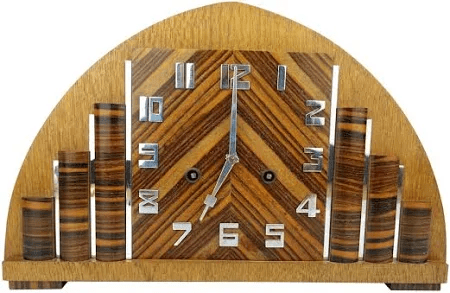Early Origins of the Shelf Clock
The shelf clock stands as one of the most practical and decorative innovations in the long history of timekeeping. Unlike massive grandfather clocks that required space in grand halls, or the portable pocket watches carried by individuals, the shelf clock was designed to be both functional and adaptable within the average home. Its earliest forms can be traced back to the late 18th and early 19th centuries, particularly in America, where clockmakers began producing compact wooden-cased timepieces that could easily rest on a mantel, shelf, or table.
One of the most influential pioneers in this development was Eli Terry, a Connecticut clockmaker who revolutionized clockmaking with interchangeable wooden parts and mass production. Terry’s clocks were affordable, reliable, and small enough to fit in homes of modest size, making the shelf clock a centerpiece of domestic life in the early 1800s.
Materials and Design of the First Shelf Clocks
Early examples of the shelf clock often had wooden movements rather than brass. This was a practical solution that kept costs down for families who desired an attractive but affordable clock. Over time, brass mechanisms became more common, adding durability and precision.
The cases were usually crafted in simple rectangular forms, although styles quickly evolved. Some featured reverse-painted glass tablets with colorful motifs, while others boasted finely carved columns or patriotic symbols. In fact, the artistry of these clocks contributed as much to their popularity as their ability to keep time.
By the mid-19th century, American clock manufacturers like Seth Thomas and Ansonia were creating highly decorative shelf clocks in styles ranging from Gothic Revival to Rococo. These designs allowed the clock to serve not just as a timekeeper but also as a statement piece in the home.
Versatility in the Home
One of the main reasons for the enduring appeal of the shelf clock is its adaptability. Unlike the fixed position of a tall case clock, these smaller timepieces could be moved to suit the changing needs and style of a household. A family might place one in the parlor, where guests gathered, or in the kitchen, where it could be consulted while preparing meals.
In bedrooms, a shelf clock was often found resting on a dresser, serving as both decoration and a practical way to rise on time in the morning. The mantel above a fireplace became another common setting, where the clock would often be paired with candlesticks, photographs, or small statues to create a balanced display.
The Shelf Clock as a Decorative Accent

Beyond utility, the shelf clock became an important element of interior design. In the Victorian era, for example, ornate shelf clocks with gilded details, porcelain faces, and sculptural elements reflected the tastes of a more decorative age. In simpler rural homes, plain wooden-cased clocks represented practicality and modest elegance.
Today, collectors often appreciate how these clocks add historical character to a room. A simple wooden ogee clock, with its rectangular shape and glass door, can bring a sense of authenticity to an antique-inspired setting. Meanwhile, a more elaborate figural clock, perhaps shaped with classical columns or adorned with a painted scene, can serve as a striking conversation piece.
Symbol of Progress and Family Life
The shelf clock was more than just a functional item—it was often considered a symbol of progress and prosperity. In the 19th century, owning a reliable timepiece demonstrated both financial stability and a commitment to punctuality, values that were deeply important in an industrializing society. For many families, the clock became a cherished possession, handed down through generations.
Some even took on sentimental meaning, marking the rhythm of daily life—when to begin chores, when to attend church, or when to gather around the dinner table. In this way, the clock became woven into the very fabric of family routines.
Modern Appreciation of the Shelf Clock
Today, while digital devices dominate timekeeping, the antique clock still holds a special place in homes and collections. Antique examples are prized for their craftsmanship and historical value, while modern reproductions continue to offer the charm of a traditional clock with updated mechanical or quartz movements.
Home decorators find them useful as focal points in living rooms, studies, and libraries. Whether placed on a mantel, bookshelf, or console table, the presence of a classic antique clock brings warmth, nostalgia, and sophistication.
Conclusion: A Timepiece That Stands the Test of Time
The story of the shelf clock is one of ingenuity, adaptability, and enduring beauty. From Eli Terry’s early wooden-movement models to the decorative masterpieces of later centuries, these clocks have evolved alongside domestic life, finding their place in nearly every room of the home. They remind us that timekeeping is not merely about precision—it is also about tradition, artistry, and the daily rhythm of family life.
Even in the modern age, when technology rules, shelf clocks continues to hold its place as both a functional and decorative treasure. Its journey from early American workshops to today’s homes proves that the value of craftsmanship and timeless design never goes out of style.


